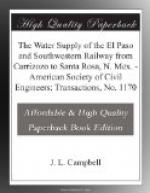The third, or gravity section, extends from the reservoir on the Corona summit to the Rio Pecos at Mile 272, dropping from an elevation of 6,750 to 4,570 ft. in 80 miles. The pipe line extends to Pastura, 58-1/2 miles from Corona, as shown on Plate V.
Where the pipe line passes a water tank on the railway, a 4-in. branch pipe is carried to the bottom of the tank and up to the top, where it is capped by an automatic valve. A gate-valve is placed in the branch pipe at its junction with the pipe line.
There are regulating, relief, check, blow-off, and air-valves, air-chambers, and open stand-pipes on the line, too numerous to mention in detail. They are designed to keep the wood pipe full, regulate flow, prevent accumulation of pressure and water-hammer, and remove sediment.
Water Pipe.—A study of the profile developed a system of hydraulic grades, pipe diameters, and open stand-pipes limiting the pressure to 130 lb. per sq. in., except on 19 miles of the pump main between Coyote and Corona where the estimated maximum pressure is 310 lb.
Investigation justified the assumption that wood pipe under a pressure of 130 lb. would give satisfactory service for 25 years, on which basis it would be less expensive than cast iron, and therefore it was used. Cast iron was considered preferable to steel for pressures not exceeding 310 lb. on account of its greater durability.
Wood Pipe.—Machine-made, spirally-wound, wood-stave pipe, made in sections from 8 to 12 ft. long, with the exterior surface covered with a heavy coat of asphalt, was selected in preference to unprotected, continuous, stave pipe. The diameters were not so great as to require the latter.
The first 40 miles of wood pipe was furnished by the Wykoff Wood Pipe Company, of Elmira, N.Y., and the Michigan Pipe Company, of Bay City, Mich., delivered the remaining 76 miles.
The pipe is wound with flat steel bands of from 14 to 18 gauge and from 1 to 2 in. wide. The machine winds at any desired pitch and tension. At each end the spiral wind is doubled two turns, the second lying over the first and developing a frictional resistance similar to that of a double hitch of a rope around a post. The ends of the band are held by screw nails or a forged clip, the latter being the better. It has two or three spikes on the under side which seat into the stave, and two side lugs on top which turn down over the band. The latter passes twice over the seat on the clip, the first turn holding the clip to the stave, while the second turn is held by the lugs which are hammered down over it. The end of the band is then turned back over the clip and held down by a staple.
The staves are double-tongued and grooved and from 1-3/8 to 2 in. thick. The smaller thickness is sufficient. The exterior face of the staves should be turned concentric with the axis of the pipe and form a circle, so that the band will have perfect contact with the wood.




